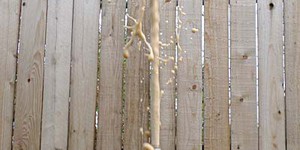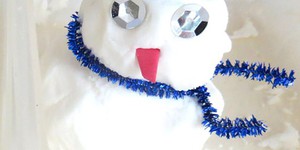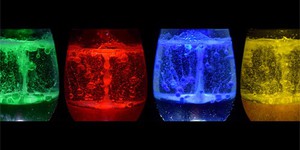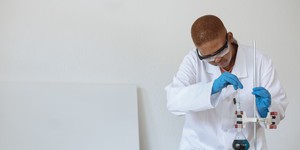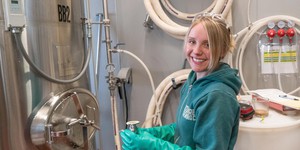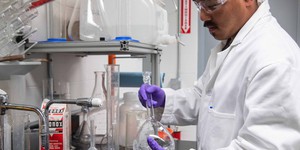Summary
Introduction
Create a giant foaming reaction and wow your friends with this classic science demonstration! With just a few simple ingredients, you can make something that looks like toothpaste being squeezed from a tube—but so big, it must be for elephants!
Materials
- Empty plastic bottle
- Warm water
- Liquid dish soap
- Liquid food coloring
- 3% hydrogen peroxide. See the Further Exploration section for instructions on using a higher concentration of hydrogen peroxide.
- Measuring cups and spoons
- Safety glasses
- Large tub or tray to catch the foam, or outdoor location to do the experiment
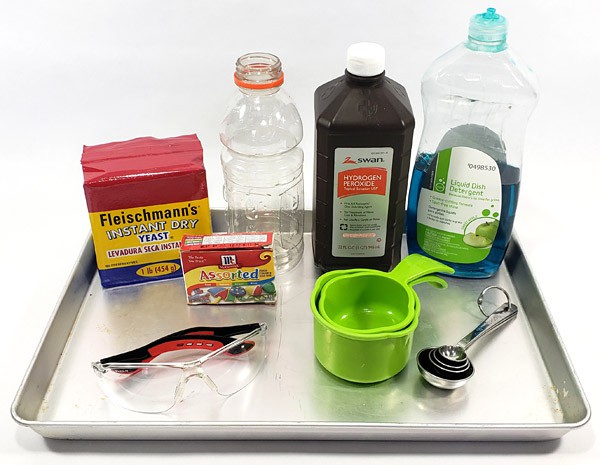 Image Credit: Ben Finio, Science Buddies / Science Buddies
Image Credit: Ben Finio, Science Buddies / Science Buddies
Disclaimer: Science Buddies participates in affiliate programs with Home Science Tools, Amazon.com, Carolina Biological, and Jameco Electronics. Proceeds from the affiliate programs help support Science Buddies, a 501(c)(3) public charity, and keep our resources free for everyone. Our top priority is student learning. If you have any comments (positive or negative) related to purchases you've made for science projects from recommendations on our site, please let us know. Write to us at scibuddy@sciencebuddies.org.
Prep Work
- Wear safety glasses to do this experiment, since hydrogen peroxide can irritate your eyes.
- The elephant toothpaste will bubble up out of the bottle. Do the experiment in a tray or tub (or outside) so it is easy to clean up all the foam.
Instructions
- Pour 1/2 cup of hydrogen peroxide into the bottle.
- Add a big squirt of dish soap into the bottle, and swirl gently to mix.
- If you want to make your foam a single color, add a few drops of food coloring directly into the hydrogen peroxide, and swirl the bottle gently to mix. If you want to give your foam stripes like some toothpastes, put the drops along the inside rim of the bottle's mouth. Let them drip down the inside of the bottle, but do not mix.
- In a measuring cup, mix together 1 tablespoon of yeast and 3 tablespoons of warm water. Stir for about 30 seconds.
- Pour the yeast mixture into the bottle, then quickly step back and watch your reaction go!What happens? How long does the reaction last?
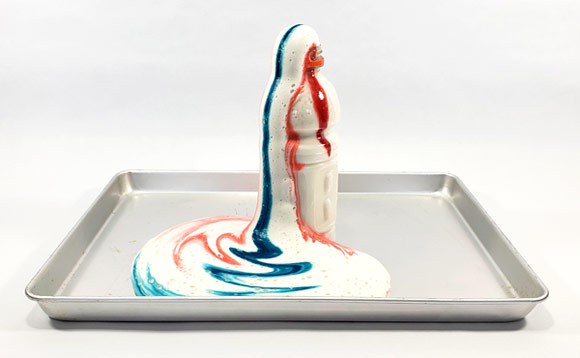 Image Credit: Ben Finio, Science Buddies / Science Buddies
Image Credit: Ben Finio, Science Buddies / Science Buddies
Cleanup
- Wash the foam down the sink when you are done with the experiment.
What Happened?
You probably saw lots of bubbles and foam in this activity. What made the foam appear? When the hydrogen peroxide comes into contact with the yeast, it starts breaking down into water and oxygen. Oxygen is a gas and therefore wants to escape the liquid. However, the dish soap that you added to your reaction traps the gas bubbles, forming a foam. The reaction continues as long as there is some hydrogen peroxide and yeast left. Once one of them runs out, it stops making new foam. If you try the experiment without dish soap, the reaction will still make bubbles, but not foam. See the Digging Deeper section to learn more about the chemical reaction.
Digging Deeper
H2O2 is the chemical formula for hydrogen peroxide. It is available in various concentrations, most commonly 3%, which you can buy at a pharmacy. It is used as an antiseptic, which means it can kill bacteria. In fact, it has been used as an antiseptic for about 200 years. Hydrogen peroxide is relatively unstable when exposed to light, which is why it is usually stored in dark brown containers. Light decomposes it into oxygen (O2) and water (H2O). At the same time, heat is generated. Usually, this decomposition reaction happens very slowly. However, certain compounds, called catalysts, can make the reaction happen much faster.
The decomposition of hydrogen peroxide can be catalyzed by various compounds, such as sodium iodide or yeast. In yeast, there is an enzyme called catalase that functions as the catalyst. Catalase is a very common enzyme that is present in almost all organisms that are exposed to oxygen. The purpose of catalase in living cells is to protect them from oxidative damage, which is damage to cells or other molecules in the body caused by oxidative compounds. This damage is a natural result of reactions happening inside your cells, which create by-products like hydrogen peroxide that can be harmful to the body.
To prevent such damage, the catalase enzyme helps break up hydrogen peroxide into harmless water and oxygen. This means if you mix catalase with hydrogen peroxide, it will immediately start decomposing the H2O2 into oxygen and water. The oxygen is a gas, and therefore escapes the liquid as bubbles. In combination with dish soap, it creates the famous elephant toothpaste foam!
Ask an Expert
For Further Exploration
- Try the experiment with differently-shaped containers. What happens if you use a bottle with a narrower or wider neck, or a cylindrical drinking glass with no neck?
- You can do this experiment with higher concentrations of hydrogen peroxide. The higher the concentration, the more vigorous the reaction will be.
6% and
12% hydrogen peroxide
are available from Amazon.com.
30% hydrogen peroxide
is available from Home Science Tools. Safety warning: additional safety precautions and adult supervision are required when working with higher concentrations of hydrogen peroxide:
- It is not safe to get this hydrogen peroxide on your skin, so you will need protective gloves and clothing.
- Make sure you wear eye protection.
- The foam will shoot up very high out of the bottle, so you will need to do the experiment outdoors.
- Do not touch the resulting foam, which may still contain some unreacted hydrogen peroxide.






